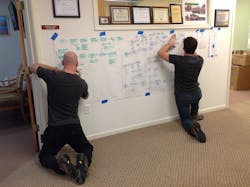This article originally appeared in the October 2023 issue of Security Business magazine. When sharing, don’t forget to mention Security Business magazine on LinkedIn and @SecBusinessMag on Twitter.
Large projects have long been the lifeblood of a traditional security integration company; however, the changing business landscapes today have pushed many an integrator – sometimes kicking and screaming – into the managed services and subscription-based world. That said, even with declining margins, large enterprise projects, if managed correctly, can provide a vital and sizeable revenue stream for integrators.
It makes sense to most business owners, but often, the eyes of sales executives and business owners can get bigger than their actual appetite, as the saying goes. If your company is a medium-sized regional integrator accustomed to $1-2 million projects, an $8 million project coming up for bids is enticing, but is your company ready for it?
“Sometimes your eyes might be bigger than your stomach and if you are a smaller company, it looks delicious,” says long-time integration business“You have to build up your resume,” Boucherle adds. “Rather than having a big elephant bursting through the wall and tearing your company to pieces, you want to build a family of elephants. You want to start with projects at one level, then go up to the next and the next. The more you do this foundationally, GCs and customers will have a lot more confidence for you to take that next step in the project, but you can't go from a million and a half to 6 million. That's too big of a leap of faith for them.”
Large projects can stretch a company and its resources, so it is vital that integrators do not leap into a situation unprepared. So how do integrators effectively tackle large, enterprise projects? During an educational session at May's PSA-TEC Conference in Dallas, Boucherle outlined the characteristics of large projects, as well as five critical aspects that must be managed in order to enjoy a successful implementation.
Characteristics of Large Projects
When an integrator decides to take on a large project – even if there’s a huge payoff at the end of the rainbow – it can be fraught with risk. These projects tend to have a long sales cycle and even longer timeline to completion. They often involve complex logistics and contracts, increased insurance requirements, and cash flow may be tied up for months or more, so integrators need a steady flow of working capital.
“Cash flow on a large project is huge, and if you do not plan for it, that one element can kill you,” Boucherle says. “This is especially true when suppliers are looking for their money for the products you ordered and maybe there is a delay on construction. You are losing cash every day when that happens.”
Along with those risks come high customer expectations, which could come from the end-customer or the general contractor, or even the electrical contractor.
“If you aren’t the prime, you can't really reach out and touch the customer and tell them why it’s important that you do something a certain way,” Boucherle says. “That can be very hard to manage.”
There’s more. Large projects may require additional training or even hiring to achieve the desired outcome. Then there’s uncontrollable circumstances that Boucherle warns “come with every big project I've ever been on.”
5 Critical Aspects of Large Project Management
When it comes to large projects, integrators all know that there are a lot of tasks involved. An enormous number of things have to be done, including project definition, document management, planning, resource allocation, customer communication and engagement, budgeting, quality assurance – the list goes on.
To prepare for all of these tasks, as well as any contingencies, Boucherle recommends the following five critical processes to manage the impact of large projects.
Project Planning
Despite the recent supply chain meltdown, many integrators prefer the “Just-in-Time” method of project management. Just-In-Time, of course, means delivering the right thing to the right place at the right time, but digging deeper, it is all about focusing the right level of energy on the right activities at the right time. It is a way for integrators to be efficient and productive, without wasted time or energy.
Using a small project as a case study example, Boucherle explained that the first critical aspect of Just-in-Time project management is inventory. “A small integrator can’t just use credit cards to buy a quarter-million dollars of hardware and then have it sit on a shelf waiting,” Boucherle explains.
Planning also involves technical training and pre-programming. “All the technology that would be deployed on this project had to be programmed ahead of time. We had to consolidate assemblies, so we took all the different pieces apart – the lens, the camera, and the housings – and we put it all together in a shop and tested it. Then we programmed IP addresses.”
Boucherle did all those things, put it in a box with a label on it, and delivered it to the job site. “It made it simpler for us, obviously. We didn't have to hold as many hands. Did we have to do more pre-work? Yes. Do I encourage everyone to do that? I absolutely do. It will make things so much smoother.”
In addition, cross-training teams, agility and resilience are really huge, Boucherle says. “If you are smaller, people have to wear different hats. They must know if that person with that hat got sick, had an accident, something went wrong, you can't leave a gap, because that gap will kill a big project.”
Communication
The link to all the many aspects of a large project is “not only communications, but excellent communications,” Boucherle says, noting that this includes communications both within your company among team members, as well as everyone else on the project, including the electricals, and the GCs, and the customers, the suppliers, etc.
People have different styles of communication, and knowing these styles are important for discussions on large projects – with customers, suppliers and internal teams. You need to be able to understand how to communicate with each type of person and adjust your style.
Boucherle points to four key “Cs” of communication:
- Capable: “Before I communicate to somebody that something needs to be done, I ask myself: Are they capable of doing what I am going to ask them to do? Have they been trained?” Boucherle says. “If that question is not answered yes, then you must stop and either make sure or find somebody else.”
- Clarity: Your communication to that individual or that team has to be crystal clear.
- Commitment: This is the one thing in good communication that almost everybody misses, Boucherle says. “After I determine you are capable, and I clearly define to you what I want, then it is time to ask them: Is it fair to do it in this timeframe? Commitment is them saying, ‘yes, I can do it.’ If they need more time, you have to give them the ability to get feedback to you.”
- Consequences: These can be both positive and negative, Boucherle says. “I'll tell people, ‘If you get that done, we will get the next big project. If not, we’ll be in default and have to write a check for $20 grand.”
Process Mapping
It may seem daunting, but process mapping is easy, Boucherle explains. “You get the team together and you put butcher paper on the wall, then you getThe installation team may add boxes on filing project paperwork; the teams from sales, operations, finance, billing – all teams involved add in their steps and responsibilities on a project.
“You will end up with a room full of this paper on the wall, and then each team explains to everybody in the company their process,” Boucherle says. “Not only does this cross-train and educate other people in the company on all the different aspects of a job, but it also breaks down company silos because you can see it from a team-to-team perspective.”
The next step involves everybody in the company tearing that process apart from their own perspectives. For example, one team may look at a process and say, “This screws me up when we do that,” or, “when you do this, it really makes my customer mad.” The process map is then improved and envisioned differently with input from the different teams. “When everybody gets involved and starts doing it, a magical thing starts to happen: Communication improves, new ways of doing things emerge, and your projects go much smoother,” Boucherle says.
The Qualification Phase
An unbridled sales team looking only at their commissions and large projects is a recipe for disaster, Boucherle warns. “Before taking on a large project,Editor’s Note: For more on defining the ideal customer for your business, see last month’s Security Business cover story, where our expert integrator roundtable tackled this very issue. Read it online at www.securityinfowatch.com/53069698.
Cash Flow is King
Cash flow, in short, is having a steady flow of cash in on a project – not just at the end, but also during and throughout. Your people need to be paid to be on the ladders for the next month. The equipment must be there just in time to be installed. Parts of the project may need to be outsourced. The list goes on. Integrators should proactively manage cash flow issues with contingency planning.
When it comes to payments, Boucherle advises to always understand what the payment looks like and understand the acceptance procedures for them when it comes to paying you. “If you don't understand that right off the bat, don't take the project,” he says.
Second, determine your purchasing logistics based on the project’s construction schedule. “I want to know what the phasing is on the construction, so it gives me some idea on timing. Of course, that can vary due to unforeseen circumstances, such as bad weather.”
Final Advice: Think Backwards
Boucherle notes that most people look at large projects in a linear way. It is a step-by-step process, and most people literally walk their way through it one piece at a time noting who will take care of each step.
Instead of linear thinking, Boucherle advises using inverse thinking: “Start out by asking yourself ‘How can we screw this project up? How can every step of this project be screwed up? If you think in those terms, when you evaluate a project, it will give you a roadmap of things you have to fix before you even take on a project.”
Paul Rothman is Editor-in-Chief of Security Business magazine. Email him your comments and questions at [email protected]. Access the current issue, full archives and apply for a free subscription at www.securitybusinessmag.com.
About the Author
Paul Rothman
Editor-in-Chief/Security Business
Paul Rothman is Editor-in-Chief of Security Business magazine. Email him your comments and questions at [email protected]. Access the current issue, full archives and apply for a free subscription at www.securitybusinessmag.com.




